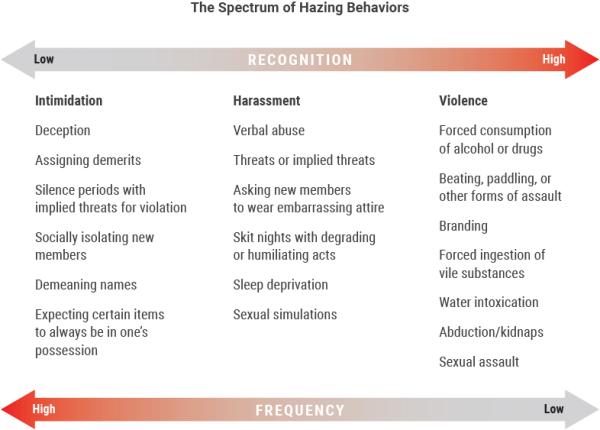How do you define hazing?
Hazing is defined as:
Any activity expected of someone joining a group (or to maintain full status in a group) that humiliates, degrades, or risks emotional and/or physical harm, regardless of the person's willingness to participate.1
Hazing has existed for hundreds of years. The first documented hazing death in the U.S. was in 1838, but the first documented alcohol-related hazing death did not occur until 1940.2
Most states have laws against hazing. Check your state's laws through StopHazing's interactive map.
What kinds of groups haze?
Hazing can happen to anyone, and can happen in any organization in which there is a hierarchy. Hazing happens in all types of student organizations: academic clubs, fraternities and sororities, marching bands, and athletic teams are some examples of groups in which hazing can and does occur. Hazing is far too common among college students, with 55% of those involved in clubs, teams, and organizations experiencing hazing. Nearly three-quarters of college student-athletes experience hazing while in college, which is slightly higher than those who experience hazing in fraternities and sororities. 47% of college students report hazing experiences while in high school and, as a result, many students expect to be hazed in college.3
What does hazing look like?
Hazing can happen at any point in one's membership experience, and can take many forms. Students may not recognize the most common forms of hazing, which contributes to underreporting. See the Spectrum of Hazing Behaviors4 below for an illustration of how the most frequent forms of hazing often go unrecognized as hazing.
Image posted with permission: Citation: Allan, 2015; Allan & Kerschner, 2020; Adapted from Bringing in the Bystander
See text-only version of the above image at The Spectrum of Hazing Behaviors Description.
Students worked with the Gordie Center to create the SAFE? acronym below to help their peers determine if what they are experiencing or seeing is hazing:
Does hazing always involve alcohol or other substances?
No, not always. But the most frequently reported form of college hazing is participating in drinking games, such as consuming a fifth of liquor (17 drinks). This combination leads to numerous injuries needing medical treatment, or death. Since January 2000, over 100 people have lost their lives due to hazing activities in the United States. Of those, 60 were related to substance use, nearly always alcohol.5
Coercing people to drink intensifies the power differential between hazers and those being hazed, increasing the odds that hazing victims will comply with unreasonable or dangerous requests. Even small amounts of intoxicating substances impair judgment, which makes it more likely that students will engage in risky behaviors they would never do otherwise.
What are some other components of hazing?
Secrecy is one. The hazers know what will happen, while those being hazed are blind to the actual risks. Hazing strategies such as kidnapping, blindfolding, or other forms of sensory deprivation are used to produce anxiety in a misguided attempt to promote group loyalty and bonding.
Students want to feel like they worked hard to achieve the privilege of being part of a group, and one of the most persistent challenges in ending hazing is that many students believe hazing victims have willingly agreed to the hazing. But the psychology of hazing makes consent nearly impossible. How can someone consent to an activity when the details are purposefully hidden from them? And of course, a person cannot consent when intoxicated or high or make informed decisions about potential risk.
Check out the video we created in partnership with The Antonio Tsialas Leadership Foundation on the Signs of Healthy and Unhealthy Organizations to help you look for healthy organizations to join and unhealthy organizations to avoid:
Sources:
- Hoover, N., & Pollard, N. (1999). National survey: Initiation rites and athletics for NCAA sports teams. Accessed 18 April 2022.
- As Campus Life Resumes, So Does Concern Over Hazing. NPR, 4 May 2021.
- Allan, E.J. and Madden, M. (2008) Hazing in View: College Students at Risk.
- Allan, 2015; Allan & Kerschner, 2020; Adapted from Bringing in the Bystander. Image posted with permission.
- U.S. Hazing Deaths Database. https://www.hanknuwer.com. Accessed 27 January 2023.

